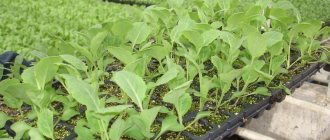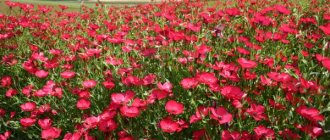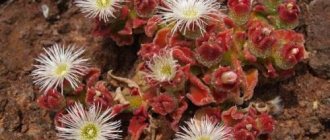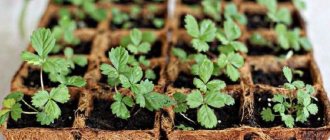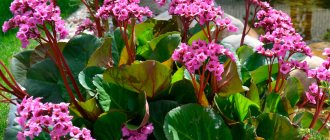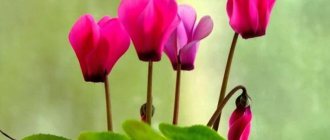Planting begonia seeds for seedlings and caring for them at home is a labor-intensive process that requires constant monitoring. However, by following all the rules of agricultural technology, you can get healthy and beautifully flowering plants for a long time.
Most often, decorative deciduous and ever-flowering begonia species are grown from seeds. However, tuberous varieties can also be obtained through seedlings, although this process is very long and labor-intensive.
Begonia seeds are recommended to be planted at the end of February or in the first ten days of March. At this time, daylight hours quickly increase and maintaining the required temperature becomes easier.
Description of the plant and popular varieties
Begonia is a low growing shrub or herbaceous plant with beautiful bright flowers. The leaves and stems differ in shape and color depending on the type of flower. The following types of begonia are most often grown at home:
Ampelous - it has cascading shoots up to 45 cm long. Flowers are formed after 5-6 leaf nodes in the leaf axils. Each flower lives up to 10 days, and after falling, a new one appears in its place. Thanks to this, the plant seems to bloom continuously until late autumn. The most popular variety of hanging begonia is considered to be Chanson; it has beautiful white or yellow lush flowers.
Tuberous - has a tuberous rhizome and a tall fleshy stem, which reaches a height of about 80 cm. There are varieties with simple and double flowers that resemble roses, camellias, carnations or peonies. Flowers can be small, up to 3 cm in diameter, or large, up to 20 cm in diameter. They can be located singly or in inflorescences. The most popular varieties of tuberous begonia are Duck Red, Picoti Harlequin, and Bouton de Rose.
Ever-blooming is a complex hybrid that combines all varietal qualities. It is a low-growing shrub with fleshy stems and smooth, heart-shaped leaves. Flowers can be painted white, pink and red, collected in various inflorescences. Among the ever-blooming begonias are terry varieties, the flowers of which have a huge number of petals. They resemble small roses. In total, there are about 600 varieties of ever-flowering begonia, among which the most commonly grown at home are Ray, Queen, and Cocktail.
Bolivianum is a tuberous plant with long drooping stems that grow up to 80 cm and hang down in several tiers. The flowers are formed in several pieces on short peduncles and have a bright orange color. This type of begonia is suitable for growing in pots and containers, as it grows well in a small amount of soil. The most common varieties of this species can be called Santa Cruz, Bonaparte, Belavista.
When does a flower sprout appear?
Begonia elatior flower - home care
Ever-blooming begonia, the seedlings of which appear within 15 days after planting, requires careful care. After emergence, small sprouts reduce their growth rate and freeze for a while. It is important to ensure that the thin shoots are not damaged during watering.
Begonia sprouts after planting
Seed selection
To grow beautiful and healthy plants, you need to choose high-quality seed material. When choosing them, you should consider the following:
- Packaging time. It is recommended to choose fresh seeds that were collected this year. The longer the seeds are, the less similar they will be, even if the expiration date indicated on the package has not yet expired.
- It is more convenient to plant granulated seeds in peat tablets. They have a dense coating of nutrients that make the seeds larger.
- It is more convenient to sow simple seeds in containers or seedling boxes.
Sowing time
To grow seedlings, you must adhere to certain sowing dates. Begonia requires a lot of light, and planting too early can result in a weak crop.
Regions
The crop has a long growing season, so to obtain seedlings, seeds are usually planted somewhat earlier than other flowers.
- Southern regions - seeds are planted at the end of January.
- Northern regions - in the Urals and Siberia, seeds are sown in mid-March.
- Leningrad region - in early March.
- The middle zone is in early February.
Moon calendar
Climate features make it possible to determine the period of sowing in different regions. Specific dates for sowing begonia seedlings are helped by choosing the lunar calendar, which determines favorable and unsuitable days in the desired month.
You should not sow on the days of the full moon and new moon. The most productive days for sowing are the days during the waxing Moon, but during the waning Moon you can also carry out sowing work.
Boarding time
Begonia seeds can be sown for seedlings from the end of January until April. Everyone determines the exact sowing time independently, depending on the characteristics of the plant development cycle. To ensure that begonia blooms as early as possible, planting is carried out in January. Then, by the time the seedlings are transplanted into the ground, they will have a well-developed root system and the seedlings will quickly take root in the new location.
Begonia will produce its first flowers 5 months after sowing the seeds, so it is worth sowing them as early as possible. However, this process should not be carried out before the end of January, since weather conditions do not correspond to the natural needs of the plant.
Do not forget about the specifics of different varieties of begonia. If you sow an ever-flowering begonia early, the seedlings will already be overgrown by the time they are transplanted into open ground. It will be difficult for it to take root in new conditions because of this the plant will lose its decorative properties. The plant will begin to bloom too early and the number of buds will be much smaller. It is recommended to plant the seeds of ever-flowering begonia in February.
Tuberous begonia, on the contrary, must be sown before mid-January. Then, by the time of transplantation, the leaves and buds of the flower will have time to form.
The main thing to remember is that by choosing the right time for sowing seeds for seedlings, you will ensure the normal development of tubers and the root system of plants.
Watch the video! Growing begonia from seeds
How to choose a begonia variety
Breeders involved in the development of begonia varieties have tried to classify all varieties of the desired plant into three main categories. Knowing whether your plant belongs to one or another of the mentioned categories, you can determine what care is optimal for it and how best to propagate it.
The initial requirements for the plant will tell you how to choose a begonia variety.
Begonias deciduous
This category of begonias includes all varietal varieties of begonias that are most effectively propagated using vegetative propagation, that is, by separating leaves or shoots from the mother bush.
The reason for the preference for vegetative propagation is that for begonias of this variety it is quite difficult to obtain seeds at home, since:
- flowering greatly weakens the plant;
- Bringing flowers to seed kills the plant.
Since the beauty of the flowers of deciduous begonia varieties is not so attractive to gardeners, it is unlikely that any of them will force the seeds to appear by raping the plant.
Not all varieties of begonia bloom profusely; some varieties even die after flowering
In addition, all the difficulties mentioned can be avoided by simply buying seeds at a flower shop. By the way, the following varietal varieties of deciduous begonia are especially popular now:
- "Royal"
- "Griffin".
The second mentioned variety is a hybrid, and is valued for its large leaves that look impressive and decorate any room or garden.
To obtain leaf begonia seedlings, sowing can be done from the end of January to the end of February. However, here we are talking about begonia, which will then live in open ground, but if we are talking about a houseplant, then sowing can be done at a different time.
The temperature regime relevant for these plants is no more than 26°C and no less than 22°C
Bush begonias
This group includes the ever-flowering begonia, which is very popular among Russian gardeners. Bush varieties of the plant we are considering, unfortunately, also do not bloom profusely, with the exception of a variety called “Elatior”. However, the lack of abundance of flowering is compensated by:
- life expectancy of buds;
- lack of winter dormancy
Buying ready-made seedlings will reduce your time costs
In the case of bush begonias, the preferred propagation methods are:
- purchase of ready-made seedlings;
- self-cultivation of seeds.
It is necessary to plant bush begonias in slightly acidic soil, using shallow boxes for planting plants. The optimal sowing time is January. It is best to mix small seeds with sand before immersing them in the soil. After laying out, the pot is covered with glass. The growing temperature is 21-24°C.
Bush begonia
Tuberous begonias
This category of begonias is distinguished by its flowering with large flowers and bright colors. The plants that represent it are perfect for growing in open ground, as well as in apartment conditions. Propagation of tuberous begonias is best done through:
- leaf cuttings;
- tubers.
If you decide to propagate begonia using tubers, this is how you can do it.
- Find a large shoot of a plant whose shoots have already awakened.
- Divide this tuber into segments, each segment should be equipped with one shoot.
- At the third stage, the sections are disinfected and dried in order to minimize the risk of rotting.
- The resulting segments go deep into the soil by exactly half their size.
- After rooting, this container is covered with earth.
Initially, it is advisable to grow tuberous begonia from a seed, and only then it is necessary to propagate it for your own purposes by separating the tubers.
Tuberous propagation of begonia
Growing begonia with seeds
The technology of growing begonia from seeds differs from the well-known methods of growing seedlings for flowers, since the seeds of this plant are not like ordinary seeds from flower boxes. Begonia seeds are very small, more like dust than balls. Even poppy seeds seem large in comparison.
Preparing containers for seedlings
It is very important to choose the right container for seedlings so that they are strong and healthy. She must be:
- compact sizes;
- shallow.
The following containers are suitable for growing begonia seedlings:
- Containers for seedlings, which can be purchased at garden stores.
- Shallow wooden boxes.
- Peat tablets.
- Plastic cake molds.
In such a container it is convenient to care for seedlings and carry out picking.
Soil selection
It is from the soil that the plant receives all the necessary nutrients. The best results can be achieved using soil:
- slightly acidic;
- neutral.
This soil is sold in gardening stores, but you can prepare it yourself. To do this take:
- 2 parts of leaf soil obtained from rotting a large amount of foliage;
- 1 part peat;
- 1 part sand.
All components are thoroughly mixed and sifted through a sieve to remove excess lumps and impurities.
Seed preparation
Begonia seeds are so small that they are very difficult to work with. However, knowing some tricks, even a novice gardener can cope with this at home.
Due to its small size, the seed material cannot be soaked and disinfected. Therefore, it is necessary to disinfect the substrate.
Therefore, it is necessary to disinfect the substrate. Can:
- steam in a steam bath;
- calcine by placing the soil in the oven for half an hour at a temperature of 150 degrees;
- pickle by treating the mixture with a strong solution of manganese.
Important! No manufacturer can guarantee 100% seed germination. Pay attention to the harvesting date; hybrids are stored for no more than 1 year, varieties - up to 3 years).
It is better to buy seeds from a company that is already known to you or someone you know.
Sowing seeds
Begonia seeds are placed on the surface of the soil in pots; there is no need to cover them with soil on top.
To evenly distribute the seed over the surface of the ground, place a small even layer of snow on top and sprinkle the seeds on top. When the snow melts, the seeds will be distributed naturally on the ground.
If the snow was not used, after sowing the seeds, the soil must be moistened with warm water using a spray bottle. It is necessary to create a greenhouse effect in the container with sowing; to do this, cover it:
- glass;
- film;
- plastic cap;
- package;
- wet gauze, etc.
This cover is removed after the seedlings appear on the surface of the earth. In about 2-3 days. Before germination, crops must be kept in a room with an air temperature of 23-25°C.
Growing in peat tablets
If peat tablets are used for sowing seeds, then it is better to buy granulated seeds. This kind of sowing is much easier to carry out; moreover, there is no need to prepare containers and soil, and then pick up the seedlings.
Step-by-step technology:
- Peat tablets are placed in a tray and filled with water at room temperature so that they swell and increase in size.
- Granulated seeds are placed in the middle of the tablet without pressing the soil into the body. One tablet contains 1 granule.
- Moisten the seed from above with warm water from a spray bottle, since there will be little moisture in the peat tablet.
- To create a greenhouse effect, seed tablets are covered with a plastic container, bag or glass cup.
- Watering the plants must be done regularly through a tray so that the peat does not dry out. To do this, use a spray bottle so as not to pour too much.
- The tablets are kept in a room with an air temperature of no more than 20°C.
High-quality seeds should germinate 7-10 days after sowing, some varieties - after 2 weeks.
Next, it’s worth talking about why the seeds don’t germinate. Let us explain the most common reasons that affect the germination of seed.
Existing methods of propagation of begonia
The varietal diversity of begonias can amaze even an experienced gardener. So, in total there are about two thousand varieties of this plant, among which you can find specimens:
- annuals;
- perennial;
- evergreen;
- decorative flowering or deciduous;
- deciduous;
- rhizomatous and other varieties.
Not only are you free to choose any variety that interests you, suitable according to the desired parameters, but initially you can also determine the method in which you want to propagate this or that plant.
There are many different methods of propagating begonias that you can use, however, the most preferable is growing seedlings from seeds, since this method is highly productive
So, the most common breeding methods are:
- rooting cuttings obtained from begonia;
- tuberous division;
- growing a plant from a torn leaf plate or part of a leaf;
- dividing an adult begonia bush;
- growing seedlings from seeds.
If you are an inexperienced gardener, then the easiest way for you to grow begonia for the first time is from a tuber divided into several segments, or by cuttings, since both of these methods practically do not involve any subtleties or difficulties.
However, these simplified techniques have one caveat: they are unable to provide you with a large number of seedlings at a time, therefore, if you need to plant a large area with begonias, and you do not know how to select large quantities of material suitable for propagating begonias vegetatively, it is best for you pay attention to the sowing method of growing this plant.
Begonia seeds are sold everywhere, in the form of granules, which are very convenient to sow in the ground.
The generative method of breeding begonias, of course, is much longer and, of course, labor-intensive, however, it is this method that can show the greatest productivity.
In order for the propagation of begonia using seeds to be successful, it is necessary to follow some rules, which we discuss below in the article.
Prices for begonia seeds
begonia seeds
What affects germination
Begonia does not germinate for the following reasons:
- Old seed – flower seeds can be stored for 1-3 years, so it is better to sow seeds collected last year.
- Substrate drying out - peat should always be moist; if it dries out, it will be difficult to wet it again.
- Temperature below +25° C - it is necessary to maintain the desired temperature in the room, if necessary, use additional heaters.
- Dry air – the air in the room should have normal humidity. If it is so dry and hot, it is recommended to spray the plant with water from a spray bottle or install automatic air humidifiers.
Transplantation to a permanent place
Tuberous begonia is grown from seeds, planting and caring for planting material is no different from other varieties. After the plant germinates, it is transplanted to a permanent place of growth. Before planting, you should choose the right pot. The container should be medium in size. The roots of the plant have an average degree of development. The root shoots should not be too constrained by the walls of the pot. The steps for transplanting a plant to a permanent place of growth are as follows:
- Small pebbles must be placed in the prepared container as drainage.
- Mix the leaf mixture, peat, sand and humus in equal proportions. The resulting nutrient mixture fits tightly into the pot.
- Moisten the soil thoroughly.
- Make a small hole in the soil.
- Remove the seedlings along with the soil and place them in a new place.
- Compact the soil.
Transplanting seedlings to a permanent place of growth
If peat cups are used, begonia can be planted in a pot together with a peat container. Subsequently, the peat cup will fall into pieces.
Important! It is not recommended to use deciduous soil in areas where oak or willow grows. Such soil may contain tannins that negatively affect plant growth.
Seedling care
- For full development, begonias require regular watering, which is carried out with warm water in a tray or using a syringe under the root.
- Until the seeds have sprouted, the film or glass must be wiped daily to remove accumulated condensation. Plantings also need to be ventilated regularly.
- The seedlings should receive enough daylight, but they should not be exposed to direct sunlight so that the young seedlings do not get burned. Additionally, lighting is provided with fluorescent lamps. If the plants do not have enough lighting, they will begin to stretch out and lose their decorative appearance.
- At first, it may seem that the seedlings are practically not growing. There is no need to worry, since begonia first grows its root system and then begins to develop its above-ground part.
- 2 weeks after the emergence of seedlings, the seedlings need to be fed; for this purpose, fertilizer for deciduous and ornamental plants is used. The fertilizer solution is diluted 3-4 times the dosage recommended in the instructions.
- The soil around the grown seedlings must be loosened periodically.
- After 1-2 true leaves appear, the seedlings are planted.
When will the shoots appear?
Planting material sprouts in 10-14 days. However, in some cases, sprouts do not appear for 3-4 weeks, so there is no need to stop care.
Sometimes shoots appear after 5-6 days and the sprouts freeze in growth. This is considered a normal process for begonias and does not require intervention.
After the first shoots appear, the covering material is removed, otherwise the seedlings may get burned and die.
Picking seedlings
Picking begonia seedlings is carried out in 2 stages.
Stage 1
At the first stage, seedlings are placed with a gap of 6 cm between seedlings and between rows. A small amount of humus must be added to the soil, and after 2 weeks, complex fertilizer must be added, which can be bought at a garden store.
Stage 2
At the second stage, the seedlings are planted in separate cups or pots, the diameter of which should not exceed 8 cm. This procedure is carried out a month before transplanting the plants into open ground. The seedlings are kept in a room with a temperature of 18°C. When the weather conditions are good outside and the risk of frost returning has subsided, the seedlings are transferred to a permanent location.
Watch the video! Begonia pick
Conditions for growing seedlings at home
As a rule, seedlings appear together. After sprouts appear, it is very important to take proper care. Plants are very sensitive to changes in temperature and humidity levels.
For growing begonia seedlings, the optimal temperature is +21-23 ℃. When the second true leaf appears, the temperature can be reduced to +18 ℃, but no more. Otherwise, the leaves will begin to turn yellow and the crop will die.
The plant prefers a high level of humidity, so moistening is carried out as the top layer of soil dries. To water the seedlings, use a syringe or spray bottle so as not to harm the delicate sprouts. Water the seedlings with warm, settled water.
Diseases and pests
By following all the rules for growing begonia from seeds, you can significantly reduce the risk of seedling disease. However, you need to be aware of possible problems in order to see them in time and take the necessary measures. When growing begonia from seeds, the following diseases and pests may appear:
- Root rot, to get rid of this problem it is necessary to ventilate the greenhouse more often and reduce watering.
- Powdery mildew.
- Aphids and spider mites are controlled with insecticides and fungicides.
What you need to plant begonia seedlings: choose soil, containers, seeds
By the time of sowing begonias for seedlings, it is necessary to prepare all the necessary equipment: seeds, soil, mixture, container, material for drainage. And it is very important to choose the right materials. Let's figure out what this crop needs for successful planting:
- soil of suitable quality . What are the soil requirements for begonia seedlings? Firstly, it must be light and loose so that it is well aerated and the root system develops normally, secondly, the soil must be nutritious so that the plants receive adequate nutrition, thirdly, slightly acidic soil is preferable (pH 5.5-6, 5). In this case, it is advisable to sift the soil through a sieve (mesh size about 5 mm). You can choose one of the options below and sow begonia in the following soil: Special soil for begonia.
- A mixture made with your own hands, consisting of turf or garden soil, high-moor peat, humus, sand (in a ratio of 2:2:1:1).
- Universal soil for flower seedlings.
- It is necessary to choose a suitable container: wide, low (about 7-8 cm). For these purposes, you can use a special seedling box purchased at a gardening store. Or you can find some kind of plastic container at home (food container, vegetable container, mushroom container). That is, there are no fundamental requirements for containers, the main thing is that it is convenient for you specifically. It’s good if you have a lid that fits this container. There should also be drainage holes at the bottom of the product.
- Prepare material for high-quality drainage . It is highly recommended to place a drainage layer at the bottom of the container, which will prevent moisture from stagnating. For example, you can use fine expanded clay, perlite, small pebbles, and broken brick. The normal layer thickness is 2-3 centimeters.
- It is important to choose quality seeds . It is better to give preference to products from a reliable manufacturer with a good reputation. Since the seeds are very small, it is not advisable to prepare them; you need to immediately sow them into the soil.
- By the way, you can buy pelleted (granulated) begonia seeds; they are much larger in size and more convenient to sow.
Transplantation and further care
Begonia should be planted in open ground when the threat of frost has passed. The place is chosen sunny or in light partial shade with loose, nutritious soil. When planting in groups, the distance between plants is 30–50 cm.
This is what seedlings look like ready for planting
- For planting in hanging pots or containers, take containers at the rate of 5–8 liters per plant.
- For home cultivation, the container should be wide, but not necessarily deep, the soil should be loose and drainable.
Further care consists of weeding, moderate watering, loosening the soil and fertilizing once a month with complex fertilizer.
Plant Formation
Simple techniques allow you to have a beautiful bush shape and long-lasting lush flowering.
Each flower lives no longer than 10 days, new ones appear in place of fallen ones. Flowering will be continuous if there are a large number of shoots with buds. To speed up the formation of side shoots, the top of the stems 7–8 cm long needs to be pinched
This is especially important for ampel forms
Tuberous begonia produces male and female flowers on the same plant. Male flowers are characterized by large sizes and double shapes. The female ones are more modest: they are smaller and have only 4–5 smooth petals. To ensure more luxuriant flowering of male flowers, female flowers must be removed, since the vital forces of the plant are spent not only on flowering, but also on the formation of fruits. If you want to get your own seeds, you can leave a couple of female flowers.
End of flowering season
At the end of the season, when begonia stops blooming, you need to stop feeding and gradually reduce watering. Before the onset of frost, it is necessary to cut the stems, dig up the tubers, clear them of soil and treat them with a fungicide or potassium permanganate. Place the dried tubers in peat or sphagnum moss to protect them from drying out, wrap them in a plastic bag and put them in the vegetable storage area in the refrigerator.
When growing begonia as a perennial, you can place a pot or balcony container in the house and continue to care for the plants, and plant them in the garden in the spring.
Development problems: table of causes and remedies
Possible problems with the development of tuberous begonia growing in the garden and indoors are approximately the same.
| Manifestation of the problem | Possible reasons | Solution |
| No flowering | Low light | Move to a bright place |
| Heavy, non-breathing or waterlogged soil | Add baking powder to the soil and loosen it in a timely manner | |
| Damage during transplantation | Feed with nitrogen fertilizer or organic matter | |
| Nutrient deficiencies | Feed with complex and potassium-phosphorus fertilizer | |
| No rest period | Provide intensive care and feeding with organic matter or nitrogen fertilizer | |
| Dry air, insufficient watering | Regular watering, air humidification | |
| Pests | Use insecticides | |
| Decorative deciduous begonia variety | The reason cannot be eliminated, you need to buy another variety | |
| Begonia variety that blooms after the sixth ring on the stem | Use a stimulant | |
| Plant aging | Rejuvenate using pups or cuttings | |
| The buds fall off without blooming | Nutrient deficiencies | Feed with complex and nitrogen fertilizer, select special preparations |
| Leaves and buds fall | Drying of air or soil | Moderate timely watering, air humidification |
| Pale foliage | Lack of light | Move the plant to a place with good lighting |
| The leaves are turning yellow | Lack of water, minerals or presence of parasites | Change the soil, treat the roots with potassium permanganate |
Reproduction by division - use a leaf or root
This method is quite productive, because several flowers can be sprouted from one leaf. Some types of begonias do not have a stem, and this option is most suitable for them. It is best to propagate flowers using this method at the beginning of summer, when the air temperature rises above 20 degrees.
The strongest leaf is found on the mother plant, cut with a sharp blade and placed on a horizontal surface (for example, a cutting board). The cut line is drawn from the base of the leaf to the edges, so the leaf plate is divided into two segments.
Place river sand in a pot or box; it should be moist. Place the cut leaves on top of it with their convex veins facing the soil. The sharp end of the leaf should be hidden in the ground. If you were unable to divide the sheet plate, simply lay the sheet completely under the ground. First make thin cuts at the intersections of the veins, since young shoots sprout from them.
An interesting beautiful plant is the prominent sedum. Read about it at the link.
The plant must be constantly ventilated. Maintain soil moisture using a water sprayer. With the appearance of the first shoots, gradually increase the ventilation time. In cloudy weather and during warm nights in the room where the flowers grow, you can open the window. Transplant young plants into separate pots after three months.
There are several nuances that inexperienced gardeners should pay attention to:
- We plant the germinated cuttings in wide, shallow pots;
- cover the bottom of the container with a layer of drainage (red brick or large expanded clay);
- begonia tubers should not touch the edges of the pot, so we plant the plant so that the distance between the walls of the container and the tuber does not exceed 2 cm;
- when planting is completed, place the flower in the shade;
- after three days you can leave the begonia in a sunny place.
